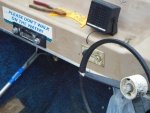YouTube lies. Let’s just start off with that.
I watched a bunch of videos that purported to show how to add a hot water heater bypass for winterization. The video magicians appear to have employed two tried and true mechanical engineer tricks.
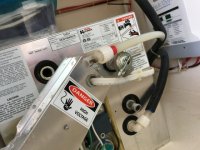
First, most of the videos I watched had the presenter doing the installation on a work bench. I don’t know about your boat but mine does not have the hot water heater sitting on a workbench.
Second, there’s a key point in each video where they employ a card magician’s trick of distracting your eye (well, my eye anyway) at a crucial point when they reconnect hoses. Magic? I say criminal malfeasance!
Of course, part of the joy of boating is learning something new every day. Let’s see what I learned.
1. Plastic plumbing fittings should be illegal. In fact, I’m thinking of running for Congress on that single issue.
2. Design engineers are either sadists or have never had to actually work with the things they engineer.
3. If there’s a way to place things so that you have to take the darn thing apart, those engineers will do it.
4. Water, fire and electricity don’t mix. Actually, the do mix when I’m around but they shouldn’t. I became slightly concerned when the Danger: High Voltage sign became immersed in water.
5. There’s a right tool for every job – and I don’t own that tool.
6. Water heater manufacturers should really design a system with the bypass already installed. SO much easier to do it in the factory rather than the bilge.
The adventure started when I attempted the simple task of unscrewing the hoses. Not happening. Get a wrench. Get vice grips. Get a lighter. Get bruised and scorched knuckles. Get a KNIFE. Get bandages.
Once the upper hose was off, I attempted the even simpler task of unscrewing the plastic elbow. Right before I crushed it with pliers, I had a moment of clarity and inserted a screwdriver into instead for leverage. Turned nicely – for a quarter revolution before it slammed into the electrical box. Take off the electrical box. Think about how that ball bearing that fell out must b=not be too important because if it was, they would have secured it better. Swear at engineers and work benches while trying to reach the bottom screw.
With the elbow off, I sat and pondered awhile. The elbow is threaded on the outside, a male connection. The C Brats approved bypass kit from Camco is also threaded on the outside, a male connection. I’m a progressive guy. I see nothing wrong with two males doing whatever they want but I didn’t think this was going to work for plumbing. It’s connecting those two ends where the YouTubers pull their card trick shenanigans. I went off to search for a female/female coupling to solve the problem. Found one at the third hardware. Back at the boat I found that it was the wrong size. Well, fiddlesticks.

Rather than going back to the hardware (it would have been my fifth trip on this little maintenance task), I decided to remove the bottom elbow as well to see if it held any surprises for me. Did it ever! I was able to pull the hose off with a bit more skill than I had used on the upper hose because I had experience. Darn that experience! Hose came off and water starting spouting out of the elbow!
Now I had drained the tank using the spigot so I don’t know where this water was coming from (the pump was off) but it kept coming so I did the only thing I could think off – I stuck my finger in the hole.
So there I am playing little Dutch boy with my finger in the dike, laid out uncomfortably on the floor and wondering what I’m going to do next. Clearances are way too tight get a bucket in there so I need to find something else – except I can’t get up to look for anything because of the old finger in the dike problem. I spent a good ten minutes pondering my next move before it dawns on me that pulling the hose off caused the problem so perhaps putting it back on will solve it – at least temporarily. I’m a little slow when it comes to mechanical stuff.
With hose reattached, I have time for an epiphany. I have a small transfer pump in the truck. What if I hook it up to the spigot and pump all the water out? Brilliant. A mere hour later I have the pump set up and primed and chugging away. Not a drop of water comes out. Guess the tank is empty. Guessed wrong. Yes, the spigot is open. Yes, the pump is primed. No, it’s not working.
I finally decide to go old school and I get a sponge and a bucket. I open the spigot over the sponge for a few seconds. Close it. Wring out sponge. Repeat.
Do you know how long it takes to empty ten gallons from a six gallon tank into a sponge? Wrong – longer than that.
Eventually the tank is empty and it’s time to figure out what to do with the mismatched connections. I head over to Lowe’s (again) to search through bins of strange looking bits of plumbing. As I’m sorting through the bins, I have to keep moving this little section of faucet hose out of the way. Some inconsiderate plumber wannabe just tossed it in there where it’s in the way…wait a minute. I pick up the hose and notice it has two female ends AND 12 inches of flexible hose. It was going to be tough reconnecting the hoses once I put the bypass in because of tight clearances but this might do the trick. I run off and find another faucet hose and am skipping my way towards the checkout when I think about the plastic fittings and how difficult it is going to be reconnecting the hoses (especially since someone, and I’m not naming names, mangled the ends of the hoses).
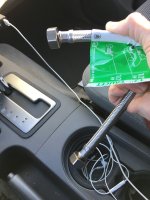
I make the only wise decision in a week. I pick up a heat gun on the way out.
Back at the boat, I channel my inner octopus and start connecting all manner of hoses, fittings and various pieces that I can’t identify. Good thing I got those faucet hoses because there was no way the original hoses would have magically fit into the new bypass configuration without divine intervention. That heat gun made quick work of reconnecting the plastic hoses too. Would have been quicker if I had not melted a couple of inches off the first one.
Finally, everything was reassembled. I had carefully used pipe tape on the metal to metal connections and hand tightened the plastic to plastic connections. I punted on the plastic to metal connections and taped half of them and left the other half bare. I told myself to make sure that the bypass valve was on bypass. I then remembered to actually put some antifreeze in the water tank.
The moment of truth had arrived. I turned on the water pump and was greeted with a beautiful Vegas style fountain show. Pink antifreeze artistically sprayed from every single connection. Lovely.
I reassessed what “hand tight” means and took a wrench to everything. Turned the pump on. No fountain show. No antifreeze coming out of faucet either. Oops. Turn on faucet. Still nothing. Hmmmm.
Telling myself to make sure the valve was on bypass and actually doing it are apparently different things. Flipped the valve. Pink antifreeze coughed out of the faucet and all over the counter and helm chair that I had just deep cleaned.
Success! It only took three days and five trips to the hardware but I now have the coolest custom bypass system ever installed.
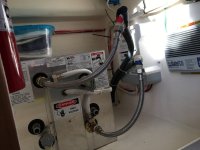
And with that, I learned my final lesson: I should have bought the six gallons of antifreeze and filled the tank with it instead of doing such a fun and simple project.
(Of course there’s no freezing weather in the 14 day forecast)
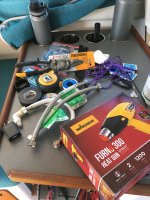
I watched a bunch of videos that purported to show how to add a hot water heater bypass for winterization. The video magicians appear to have employed two tried and true mechanical engineer tricks.

First, most of the videos I watched had the presenter doing the installation on a work bench. I don’t know about your boat but mine does not have the hot water heater sitting on a workbench.
Second, there’s a key point in each video where they employ a card magician’s trick of distracting your eye (well, my eye anyway) at a crucial point when they reconnect hoses. Magic? I say criminal malfeasance!
Of course, part of the joy of boating is learning something new every day. Let’s see what I learned.
1. Plastic plumbing fittings should be illegal. In fact, I’m thinking of running for Congress on that single issue.
2. Design engineers are either sadists or have never had to actually work with the things they engineer.
3. If there’s a way to place things so that you have to take the darn thing apart, those engineers will do it.
4. Water, fire and electricity don’t mix. Actually, the do mix when I’m around but they shouldn’t. I became slightly concerned when the Danger: High Voltage sign became immersed in water.
5. There’s a right tool for every job – and I don’t own that tool.
6. Water heater manufacturers should really design a system with the bypass already installed. SO much easier to do it in the factory rather than the bilge.
The adventure started when I attempted the simple task of unscrewing the hoses. Not happening. Get a wrench. Get vice grips. Get a lighter. Get bruised and scorched knuckles. Get a KNIFE. Get bandages.
Once the upper hose was off, I attempted the even simpler task of unscrewing the plastic elbow. Right before I crushed it with pliers, I had a moment of clarity and inserted a screwdriver into instead for leverage. Turned nicely – for a quarter revolution before it slammed into the electrical box. Take off the electrical box. Think about how that ball bearing that fell out must b=not be too important because if it was, they would have secured it better. Swear at engineers and work benches while trying to reach the bottom screw.
With the elbow off, I sat and pondered awhile. The elbow is threaded on the outside, a male connection. The C Brats approved bypass kit from Camco is also threaded on the outside, a male connection. I’m a progressive guy. I see nothing wrong with two males doing whatever they want but I didn’t think this was going to work for plumbing. It’s connecting those two ends where the YouTubers pull their card trick shenanigans. I went off to search for a female/female coupling to solve the problem. Found one at the third hardware. Back at the boat I found that it was the wrong size. Well, fiddlesticks.

Rather than going back to the hardware (it would have been my fifth trip on this little maintenance task), I decided to remove the bottom elbow as well to see if it held any surprises for me. Did it ever! I was able to pull the hose off with a bit more skill than I had used on the upper hose because I had experience. Darn that experience! Hose came off and water starting spouting out of the elbow!
Now I had drained the tank using the spigot so I don’t know where this water was coming from (the pump was off) but it kept coming so I did the only thing I could think off – I stuck my finger in the hole.
So there I am playing little Dutch boy with my finger in the dike, laid out uncomfortably on the floor and wondering what I’m going to do next. Clearances are way too tight get a bucket in there so I need to find something else – except I can’t get up to look for anything because of the old finger in the dike problem. I spent a good ten minutes pondering my next move before it dawns on me that pulling the hose off caused the problem so perhaps putting it back on will solve it – at least temporarily. I’m a little slow when it comes to mechanical stuff.
With hose reattached, I have time for an epiphany. I have a small transfer pump in the truck. What if I hook it up to the spigot and pump all the water out? Brilliant. A mere hour later I have the pump set up and primed and chugging away. Not a drop of water comes out. Guess the tank is empty. Guessed wrong. Yes, the spigot is open. Yes, the pump is primed. No, it’s not working.
I finally decide to go old school and I get a sponge and a bucket. I open the spigot over the sponge for a few seconds. Close it. Wring out sponge. Repeat.
Do you know how long it takes to empty ten gallons from a six gallon tank into a sponge? Wrong – longer than that.
Eventually the tank is empty and it’s time to figure out what to do with the mismatched connections. I head over to Lowe’s (again) to search through bins of strange looking bits of plumbing. As I’m sorting through the bins, I have to keep moving this little section of faucet hose out of the way. Some inconsiderate plumber wannabe just tossed it in there where it’s in the way…wait a minute. I pick up the hose and notice it has two female ends AND 12 inches of flexible hose. It was going to be tough reconnecting the hoses once I put the bypass in because of tight clearances but this might do the trick. I run off and find another faucet hose and am skipping my way towards the checkout when I think about the plastic fittings and how difficult it is going to be reconnecting the hoses (especially since someone, and I’m not naming names, mangled the ends of the hoses).

I make the only wise decision in a week. I pick up a heat gun on the way out.
Back at the boat, I channel my inner octopus and start connecting all manner of hoses, fittings and various pieces that I can’t identify. Good thing I got those faucet hoses because there was no way the original hoses would have magically fit into the new bypass configuration without divine intervention. That heat gun made quick work of reconnecting the plastic hoses too. Would have been quicker if I had not melted a couple of inches off the first one.
Finally, everything was reassembled. I had carefully used pipe tape on the metal to metal connections and hand tightened the plastic to plastic connections. I punted on the plastic to metal connections and taped half of them and left the other half bare. I told myself to make sure that the bypass valve was on bypass. I then remembered to actually put some antifreeze in the water tank.
The moment of truth had arrived. I turned on the water pump and was greeted with a beautiful Vegas style fountain show. Pink antifreeze artistically sprayed from every single connection. Lovely.
I reassessed what “hand tight” means and took a wrench to everything. Turned the pump on. No fountain show. No antifreeze coming out of faucet either. Oops. Turn on faucet. Still nothing. Hmmmm.
Telling myself to make sure the valve was on bypass and actually doing it are apparently different things. Flipped the valve. Pink antifreeze coughed out of the faucet and all over the counter and helm chair that I had just deep cleaned.
Success! It only took three days and five trips to the hardware but I now have the coolest custom bypass system ever installed.

And with that, I learned my final lesson: I should have bought the six gallons of antifreeze and filled the tank with it instead of doing such a fun and simple project.
(Of course there’s no freezing weather in the 14 day forecast)


